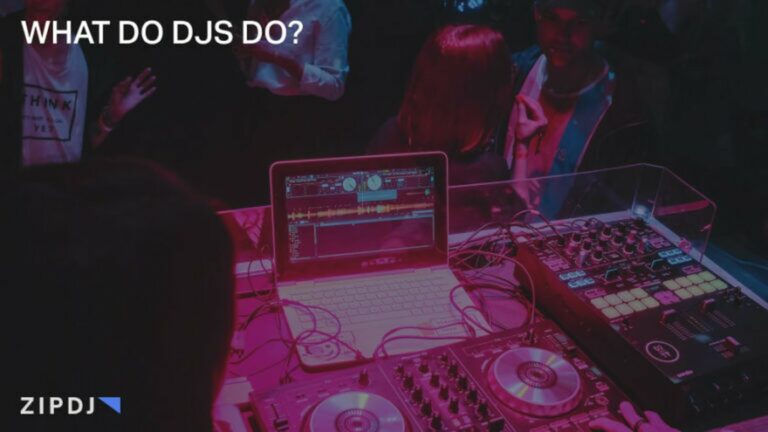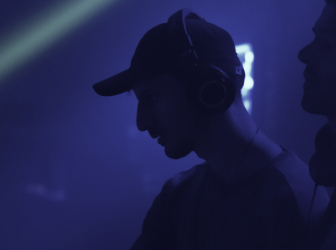What Do DJs Do? The Role DJs Play As Influencers In 2025

From world-class stars to bedroom enthusiasts, DJs do much more than press play on a pre-recorded track and sit back and relax.
Mixing music well requires a deep understanding of its structure and form, with many technical skills to master.
Read on for a breakdown of all the skills a DJ needs, from staying on top of the latest releases to honing impressive mixing techniques.

What Do DJs Do? The Role DJs Play As Influencers
While most people understand that a DJ mixes recorded music for an audience, their role as influencers in the music industry is often overlooked.
The DJ community plays a crucial role in defining musical taste, from promoting new house music to introducing genre mashups.
Successful celebrity DJs have an influence on their peers and booking agents that are hard to overstate, impacting other DJs worldwide.
Let’s get started and explore what DJs do and the crucial role they play as influencers:
What Does DJ Stand For?
DJ stands for “disc jockey,” which is someone who uses DJing equipment to play music for an audience in a variety of situations.
Whether working in bars and nightclubs or performing on radio stations, a DJ plays recorded music for a specific crowd.
Some of the best DJs also create music themselves, integrating music production with live music.
The term “disc jockey” dates back to the 1930s by radio commentator Walter Winchell, first appearing in print in a 1941 edition of Variety.
Its modern usage relating to DJs who mix recorded music is more closely associated with hip-hop DJs like Grandmaster Flash.
Now we’ve got that out of the way, here’s what DJs do on a day-to-day basis:
Master DJ Software & Equipment
Professional DJs require several crucial pieces of music equipment to perform their DJ sets in clubs and other venues.
While club DJs often use in-house DJ equipment, they still need their own setup to check new music and practice honing their DJ skills.
Essential DJ gear includes a DJ mixer and two DJ controllers, such as two CDJs or vinyl turntables for mixing records.
DJ mixers range from basic mixers for blending two tracks to comprehensive models featuring a selection of effects and samplers.
Often, a computer or laptop with DJ software installed is a central element of modern DJ hardware, with DJ headphones essential for all setups.
Build A Music Library
Having acquired the latest modern DJ equipment, the next thing a good DJ needs to do is compile a selection of killer music files to play.
This can range from collecting vinyl records from online stores and second-hand sellers to building a digital music collection.
Many popular online record stores, such as Beatport and Boomkat, sell the latest dance music on a track-by-track basis.
Alternatively, many DJs opt for a subscription to a record pool since they can use DJ pools for promotion to increase their reach.
While most DJs tend to limit themselves to one primary genre, radio DJs and mobile DJs play a more eclectic mix and use DJ pools for this reason.
Arrange Song Selection
A strong DJ mix requires careful consideration on the part of the DJ so that the songs are played at the best possible time during a set.
This means curating a consistently good music flow and playing music that works well together throughout a live set.
More proficient DJs can perform a great DJ set with minimal preparation, understanding the vibe and suitability of the music in their library.
Being able to mix songs competently isn’t just about showing off technical skills; it also requires great judgment to keep the dance floor lively.
This means that many DJs will spend considerable time reviewing their music collection so they are completely familiar with its structure.
Understanding where breakdowns and drops occur in a given track allows the DJ to blend them together in sets more effectively.
It also ensures they know what key a particular track is in, making mixing songs without clashing harmonies easier.
This is another reason why DJ pools are increasingly popular among DJs since these pools include key and BPM information on their releases.
Practice Beat Matching
Learning how to beat match is the most fundamental skill any good DJ will learn before they are confident enough to approach venues.
This technique involves identifying the beats per minute (BPM) of two songs and using the DJ mixer to bring them into sync.
Beat matching is a skill that can be transferred across genres and is necessary to learn whether you’re playing techno or hip-hop.
Each measure of a given song is broken into a 4/4 beat at a given tempo, which can be matched by ear or using the BPM counter on some DJ controllers.
For example, if one track is 135BPM and another is 131BPM, DJs will either speed up the former or slow down the latter until they match.
Some genres are easier than others for beat matching, and if you’re just starting to learn how to DJ, it’s wise to choose the music you know inside out.

Master Song Transitions
Once a DJ has mastered the basics of beat matching, they can add a repertoire of transitions to blend the next track into the previous song.
There are many effective DJ transitions used by DJs to get from one track to another, from using the EQ controls to quickly cutting between tracks.
EQing is particularly effective since there are few limitations on how the low, middle, and high-frequency faders can be used in combination.
After mastering some of the basic EQ transitions, a great DJ will move on to key-based transitions based on the key of each track.
There are twelve major and minor keys with strong and weak connections with each other, represented on a key wheel.
Key transitions are especially effective when mixing songs with vocals and other strong melodies that might otherwise clash.
Chopping and cutting techniques are more commonly used for hip-hop and drum and bass DJ sets for dramatic transitions between songs.
Beat Matching With Sync
The days of mastering beat matching with pitch controls and going by ear have long been a thing of the past, thanks to the latest DJ controllers.
Many of these tools integrate advanced sync features that identify BPM instantly and match the songs for you so they’re ready to mix.
While purists complain these tools take the skill out of mixing, they create opportunities to hone advanced DJ techniques that show off your style.
Introducing samples and effects or practicing your scratching technical skills become more feasible once beat matching has been done.
Few professional DJs rely on syncing software, but these tools can certainly help beginners develop their DJing skills.
Experimenting With Turntablism
As the latest DJ technology, thanks to artificial intelligence, there’s a growing appreciation for traditional turntablism.
This is a more difficult skill to master than basic mixing with digital files and a DJ controller, but it offers a more rewarding and tactile experience.
Basic beat matching will take considerably more effort to fully master using vinyl records since DJs have to match BPM by ear.
This means listening to the incoming record in DJ headphones while playing track one and adjusting its tempo with the pitch slider.
Turntablism also includes learning how to scratch DJ, which has a much steeper learning curve and a more limited application for genres.
Those with the patience to learn scratching can transform two tracks into something completely unique and exciting.
At the top of the game, scratch DJs such as QBert, DJ Shadow, and Jazzy Jeff have made careers by showcasing top-flight turntablism skills.
Using Lighting & Special Effects
Introducing lighting and other special effects can enhance a great sound system with captivating visuals for the audience.
While most DJs can’t afford the best DJ visuals used at music festivals, there are plenty of affordable alternatives for a moderate budget.
More basic lighting packages are often used by wedding DJs to bring additional vibrancy to their sets, as well as using smoke machines.
In addition to budget-friendly lighting rigs, more complex – and impressive – light displays can be timed in sequence with the music.
Cluster strobes and orbital lights with moving heads can bring a professional atmosphere and expand the list of equipment DJs use.
While modern DJs are used to nightclubs, including such rigs in their venue, investing in lights is worth considering if you’re a mobile DJ.
Working with an animator and putting together bespoke sequences for VJing purposes is another way DJs introduce special effects to their sets.
Reading The Crowd
Knowing when to play the best song for a given moment is another crucial skill that great DJs need to master.
It’s one thing having a great playlist of music at your disposal, but knowing when to switch things up is essential to keep the crowd engaged.
A solid understanding of the psychology of music is a good foundation for reading the crowd and adjusting a mix based on their reactions.
There’s an element of multitasking involved in reading a crowd’s reactions since DJs also need to focus on actually performing their DJ set.
If the crowd loves the music, DJs will maintain the same energy, while the sight of people leaving the dance floor will lead them up the ante.
There are no set rules about reading the crowd, although a basic understanding of body language can go a long way.
It can also help DJs make better decisions, eliminating unpopular tracks while replaying hits in future sets.
Producing Their Own Music
Some of the world’s best EDM DJs take their live sets to the next level by producing their own music to play in their sets.
This can include anything from mastering drum machines to playing musical instruments and creating fresh and unique music.
There is a range of processes involved in music production and a long list of software, hardware, and other tools used to make music.
The basics of music production involve working with samples and instruments to compose melodies and arrange them in a sequencer.
Recording live instruments, editing, mixing, and mastering these sounds are all part of the production process.
It’s an excellent way for DJs to enhance their reputation among other DJs and play the music they know will fit their overall style.
Setting Up & Packing Gear
Unless they’re well established and can afford to pay a crew of technicians to set up their gear, most DJs will handle this process themselves.
Investing in high-quality flight cases for storing controllers and other expensive hardware is essential to avoid costly damage through accidents.
DJs also need to know how to clean DJ gear to ensure it isn’t damaged from dust and dirt or compromised due to spilled drinks.
It’s certainly a less glamorous aspect of being a professional DJ, but good maintenance habits are crucial for protecting your investment.
Summary
We hope this article has answered all your questions about the art of DJing and helped you develop the skills needed to succeed.
While there’s a perception that DJs simply press play and sit back, the reality is many techniques need to be mastered to DJ like a pro.
As new technology continues to emerge that reshapes how DJs work, the art form will continue to evolve in the years to come.
Start building a music library by signing up to ZIPDJ for unlimited access to the latest releases.
Not a member ?
Join Today for Unlimited Music Downloads. Visit zipdj.com for more information.



